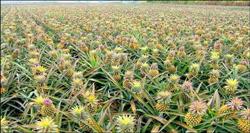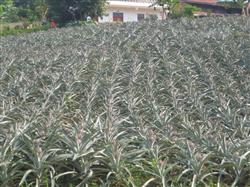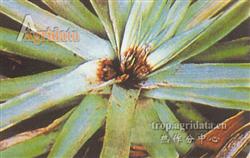How should pineapples be planted?

How should pineapples be planted? Pineapple, also known as pineapple, English name Pineapple, belongs to the pineapple family, pineapple genus, is a perennial monocotyledonous herb, growing on the ground, the fruit is an aggregate fruit formed by the aggregation of most small fruits, the general weight of the fruit is 1.5kg. Pineapple is a tropical fruit, native to Central and South America, pineapple fruit is rich in nutrients, fruit juice not only contains a large amount of vitamin C, but also has a unique flavor. The pulp contains pineapple enzyme (Bromelin), which can decompose protein, help the human body digest, eat after meals, and is beneficial to health. In addition, it has the effects of clearing heat, diuresis, detoxification, promoting fluid and relieving thirst. 1. Pineapple is widely distributed between the Tropic of Cancer and the Tropic of Cancer. It is one of the most important fruits in the world. It is cultivated in more than 80 countries and regions in the world. The main producing areas are concentrated in Thailand, the Philippines, Indonesia, Vietnam, Brazil, South Africa and the United States. China is one of the top ten major pineapple producing countries. 2. Cultivated significance pineapple fruit is of good quality and rich in nutrition. it is analyzed that every 100 grams of pulp contains 16 grams of total sugar, 0.6 grams of organic acids, 0.4 grams of protein, 0.5 grams of crude fiber, and 0.5 grams of crude fiber, and contains a variety of vitamins. Vitamin C content can be as high as 42 mg. In addition, it is rich in calcium, iron, phosphorus and so on. Pineapple as a fresh food, golden flesh, rich flavor, sweet and sour palatable, crisp and juicy. Canned pineapple is known as "international canned fruit". It can also be made into a variety of processed products and is widely welcomed by consumers. Pineapple plant has strong adaptability, barren tolerance, drought tolerance and less diseases and insect pests. It is an important pioneer crop in newly reclaimed mountain areas. It is easy to cultivate, high yield and intercropping. It is a good tree species to make farmers rich. 3. Cultivation characteristics 3.1 the biological shape of pineapple is about 1 meter high, the stem is fleshy solitary, the leaves are sword-like herbaceous, clustered on the stem, the root is fibrous whisker root, head, terminal, complete flower, fleshy compound fruit is formed by many ovaries aggregated on the flower axis. The root system of pineapple is shallow, and 90% of it is concentrated in the soil layer of 10 Murray 25 cm. The strong wind will break the stalk and blow down the plant, and the cold wind and cold rain in winter will cause the heart of the pineapple to rot. 3.2 requirements for meteorological conditions for the growth and development of pineapple requires that pineapple is a tropical perennial herbaceous fruit tree, which likes to be warm and humid, avoid low temperature frost, strong drought resistance, but good growth and development requires adequate moisture, insufficient or excessive or uneven rainfall, it should be regulated by drainage and irrigation. Pineapple is native to tropical rain forests and tropical plateaus, with strong shade tolerance, like diffuse light, avoid direct light, but high yield and high quality still need sufficient light. Pineapple is widely suitable for soil, but it is not suitable for neutral or alkaline soil, clayey or unstructured silt. PH5--6 is required. The pineapple plant is short and less harmed by the wind, but the strong wind above 6 °can also cause damage. Temperature is the most important ecological factor affecting the growth, development, yield and quality of pineapple. According to the research, pineapple can grow in 15 ℃ 40 ℃, and 28 ℃ 32 ℃ is the most suitable. 10 Mel will slow or stop growing, and if it lasts less than 5 ℃, it will cause cold injury. If it stays for 2 days, it can still survive, and if it is too long, it will be seriously damaged. Compared with other tropical herbaceous fruit trees (such as banana and papaya), pineapple has stronger tolerance to low temperature and short frost. The response of different pineapple varieties to temperature was different. The average temperature of the day was about 13 ℃, but it did not blossom until 16 ℃. Drought and extreme heat can also inhibit the blooming of flowers or lead to incomplete flowering. The length of fruit ripening period and quality are also closely related to temperature. The average temperature during the period from budding to maturity increased by 1 ℃, and the days of maturity decreased by about 8 days. If the temperature is high, the sunshine is strong, and the moisture is sufficient, the ripening period is short and the quality is good. Therefore, in general, the ripening period of summer and autumn fruit is shorter than that of winter and spring fruit, and the flavor is good. Pineapple is a drought-tolerant crop. According to research, the daily evapotranspiration of pineapple is about 4.5 mm. Even if the original water content of the soil is relatively high, as long as there is no precipitation for 4 weeks, the water in the soil can be exhausted. Therefore, attention should be paid to the proper supply of water during the growth and development of pineapple in order to ensure its normal growth and development. However, pineapple is a shallow-rooted aerobic crop with too much water and too much soil moisture, which will cause poor soil ventilation, hinder nutrient absorption and utilization, and seriously cause root rot and death. It is reported that it is more suitable for pineapple to grow in places where the annual rainfall is more than 1000 Mel 1500 mm and the precipitation time distribution is relatively uniform (monthly rainfall 100 mm). The underground water level of 30ml / 50cm is beneficial to root growth. Short-term drought in autumn and winter is conducive to flower bud differentiation and enhance plant cold resistance, but excessive drought will cause plants to become yellow, fruit stalks dry, fruit core cracking, and will lead to early maturity, small fruit, not full, light pulp color, low moisture, poor flavor, and induce wilt disease, which can reduce yield by about 20%. If there is a long low temperature and drought in winter and spring, the cold resistance of the plant will be reduced, which is not conducive to flower bud differentiation, flower bud dysplasia, or even stagnation. Therefore, when the monthly rainfall is less than 50 mm, irrigation is needed to replenish water. 3. Planting and nursery pineapple with 666.67 square meters planted 3800 murmur4000 plants, which required a large amount of seedlings. Three methods were commonly used: orthopedic sprouting propagation, vegetative propagation and tissue culture. Time and method of sprouting: plants with 40 cm long green leaves, usually 40 leaves of Cain and 35 leaves of Philippine varieties, were selected from May to November. Each plant was perfused with 250 mg / L ethrel plus 1% urea and 0.5% potassium chloride solution 25 ml, and on the 5th and 12th day after treatment, the heart was perfused with 1500 times and 600 times-750 times orthopedic solution, respectively. Vegetative propagation is often used for seedling cultivation, that is, small terminal buds, small receptacle buds, small sucking buds and fruit tumor buds in the field are pseudo-planted in the nursery and come out of the nursery. The seedlings were cultivated by using the small receptacle buds left on the fruit stalk after fruit harvest, and the old stems were propagated by cutting and renewing the old stems. Tissue culture seedlings were cultured in Ms medium at room temperature for 30 ℃, light for 12 hours or natural light. 3.4 Technical points of high quality and high yield of pineapple 3.4.1 choose the garden to sit north and south, with plenty of sunshine, rich water and convenient transportation as commodity production base. 3.4.2 before scientific planting, the barren soil should be improved, sufficient basic fertilizer should be applied, and strong seedlings should be selected for planting. Density: 4000 plants for every 666.67 square meters of caine and 5000 plants for queens. 3.4.3 strengthen fertilizer and water management after planting 3.4.3.1 Fertilizer application amount per 666.67 square meters in Guangxi, China, nitrogen 42.2kg, phosphorus 26.8kg, potassium 38.5kg, N ∶ P2O5 ∶ K2O=1 ∶ 0.62 ∶ 0.9; 3.4.3.2 Fertilizer is usually applied from December to February of the following year before budding, and from July to August after fruit harvest. Apply strong fruit budding fertilizer between bud-promoting fertilizer and strong bud fertilizer; apply foliar fertilizer once a year in April, June, July and September, topdressing twice in May and August, with 1% urea and 0.5% potassium sulfate solution, and apply base fertilizer after fruit harvest. 3.4.3.3 Water management should be timely drainage and irrigation to prevent waterlogging and drought. 3.4.4 to do a good job in other management, if the growth and development of the fruit is not affected, the buds should be removed and retained properly; in order to promote the flower, the fruit should be sprayed; in order to improve the weight and quality of the fruit, the fruit should be sprayed with 50 mg / L gibberellin plus 0.5% urea after all the florets. Spray for the second time after 20 days, spray 70 mg / L gibberellin plus 0.3% urea. In order to make the fruit mature uniformly, when the fruit develops to medium well, the fruit should be ripened with 300mg / L spray fruit. 4. Pest control 4.1 Disease control 4.1.1 after the disease of the plant, the leaves became soft and drooping, the leaves were light green to red, the base rotted, and finally the whole plant withered. The disease is caused by pink scale insects. Prevention and control methods: first of all, pay strict attention to the propagation of diseased seedlings. Secondly, kill the pink scale beetle in time, soak the head with 500 times dimethoate solution and plant it after being cold and dry. If you find the damage caused by pink scale insects after planting, spray dimethoate 500x liquid in time, or 25% Chinese family meiling 1500 times liquid. If diseased plants are found, they should be dug up in time to prevent them from spreading. 4.1.2 the core of the affected fruit blackened and gradually expanded to the whole fruit rot, and the pathogen was mostly invaded by the bud picking place and the fruit stalk wound. Prevention and control methods: be careful not to top and pick fruit in rainy days, so as to reduce the chance of germs invading. This disease is also the main disease of storing pineapple fresh fruit. 4.1.3 Seedling heart rot to control seedling heart rot and death. It is mainly caused by stacking heat or stagnant water. Prevention and treatment: avoid stacking seedlings for too long, especially in the process of long-distance transportation, so as to avoid fever and injury caused by high temperature, high humidity and airtight. Spread out as soon as you arrive at the destination, plant after a little sun for 1 or 2 days, avoid planting in rainy days, and pay attention to deep ploughing and shallow planting. 4.2 pest control 4.2.1 pineapple pink scale control 4.2.2 grub control 4.2.3 when the fruit is bitten by big-headed crickets when the fruit is ripe, the fruit quality will be poor and become a grade outer fruit. Control method: 1 kg of fried sweet potato with 5 dry grams of rice bran is mixed with a small amount of pickle juice, and then 100 grams of 90% crystal trichlorfon are added to make a poison bait the size of beans, and each bait is trapped around the plant at night. 5. Species and varieties the cultivated varieties of pineapple are usually divided into four categories, namely, Cain, Queen, Spanish and Hybrid species. 5.1 Cain, also known as Sarawak, was discovered by a French expedition in the Guiana Caine region of South America. It is widely cultivated, accounting for about 80% of the cultivated area of pineapple in the world. The plant is tall and sturdy, the leaf margin is unarmed or the leaf tip has a few spines. The fruit is large, with an average single fruit weight of more than 1100 grams, cylindrical, flat fruit, shallow eyes, short and wide bracts, light yellow pulp, juicy, moderate sweetness and sour, soluble solids 14% Mui 16%, high up to 20%, and acid content 0.5% 0.6%. It is the main variety of canning. 5.2 Queens is the oldest cultivated variety with a history of more than 400 years. It is one of the main varieties in South Africa, Vietnam and China. The plant is medium-large, the leaf is shorter than caine, the leaf margin is spiny; the fruit is cylindrical or conical, the single fruit weighs 400-1400g, the fruit cone is raised, the fruit eye is deep, and the bract tip exceeds the small fruit; the flesh is yellow to dark yellow, the flesh is crisp and tender, the sugar content is high, the juice is sweet, the aroma is rich, and it is mainly fresh. 5.3 Spanish type plants are larger, with soft, yellowish green leaves with red thorns on the leaf margin, but there are also unthorn varieties; the fruit is medium-large, with a single fruit weighing 500Muth1000 grams, and the small fruit is large and flat, raised or sunken in the center; the fruit has deep eyes, orange flesh, strong fragrance and much fiber, which is used for canning and juice. 5.4 hybrids are improved varieties cultivated by means of sexual hybridization. The plant is tall and erect, the leaf margin is spiny, the flower is lilac, the fruit shape is not correct, and the single fruit weighs 1200 Mel 1500 grams. The flesh is yellow, crisp, less fiber, sweet and delicious, soluble solids 11% murmur15%, acid content 0.3% Murray 0.6%, not only fresh food, but also canned. Click to get more pineapple planting techniques click to get more fruit planting techniques
- Prev

How to plant pineapples?
How to plant pineapples? Please give guidance to pineapple cultivation can refer to the following methods: 1, the base fertilizer is generally based on pig manure, plus the same amount of ash fertilizer, compost retting. If lack of column fertilizer, compost, garbage fertilizer and other soil fertilizer can also be used, but each mu should be mixed with phosphate rock powder and bran fertilizer of 50 kg per mu.
- Next

How to prevent and cure the heart rot of pineapple seedlings?
How to prevent and cure the heart rot of pineapple seedlings? Please give guidance on the heart rot of pineapple seedlings caused by heart rot. It is mainly caused by stacking heat or stagnant water. Prevention and treatment: avoid stacking seedlings for too long, especially in the process of long-distance transportation, so as to avoid fever and injury caused by high temperature, high humidity and airtight. ...
Related
- Moge, come on! The staff of the peasant association in the producing area of cantaloupe were frightened when the crowd gathered.
- Causes and Solutions of low Fruit setting rate of Apple
- Symptoms and control measures of passion fruit virus disease
- Fruit growing lesson: how do apple orchards keep high yields?
- Can you build orchards in the mountains? What are the pros and cons?
- How to manage the coloring period of Crisson grape?
- This paper introduces the processing technology of two kinds of fig products.
- How much is a month for retired teachers in rural areas by 2020?
- How can strawberry planting increase sugar content? We should pay attention to management in many aspects.
- What are the cultivation techniques on how to improve the yield of golden fruit?

